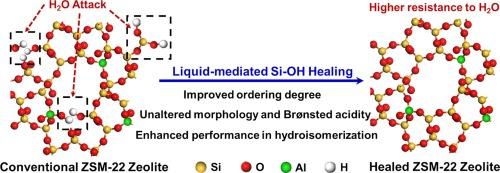对 ZSM-22 沸石进行 Si-OH 缺陷修复处理,以提高其在正烷烃加氢异构化过程中的性能和耐酒精性
IF 6.7
1区 工程技术
Q2 ENERGY & FUELS
引用次数: 0
摘要
随着生物质原料升级为可持续航空燃料的潜在应用,在提高 ZSM-22 沸石的加氢异构化性能的同时改善其对残留含氧化合物的耐受性至关重要。作为 ZSM-22 沸石的缺陷位点,丰富的 Si-OH 基团与催化性能和稳定性密切相关,是生成水的主要攻击位点。本研究采用液体介导的缺陷愈合处理方法,将 Si-OH 愈合为 Si-O-Si ,从而在不影响硅/铝、微孔体积和形态的前提下提高了结晶度和孔隙连通性,避免了传统硅化和硅化过程造成的微孔堵塞和脱胶现象。Si-OH 基团减少的结果是路易斯酸位点的减少,而不会改变布氏酸度。在正十二烷加氢异构化过程中,通过液体介导缺陷愈合处理路线获得的催化剂与母体和通过其他愈合方法制备的愈合催化剂相比,转化率和异构体产率均有所提高。这主要是由于微孔空隙的封闭性增强,从而降低了表观活化能,减少了易裂解的多分支异构体的产率。此外,愈合后的催化剂在含有丁醇的原料的加氢异构化过程中表现出更强的抗性和结构稳定性。这项工作为 ZSM-22 沸石通过基本的 Si-OH 愈合方法在复杂和严重反应物的加氢异构化中的应用提供了前景。本文章由计算机程序翻译,如有差异,请以英文原文为准。

Si-OH defect healing treatments of ZSM-22 zeolites for enhanced performance and alcohol resistance in n-alkanes hydroisomerization
With the potential application of biomass-derived feedstock upgradation to sustainable aviation fuels, it is essential to enhance the hydroisomerization performance of ZSM-22 zeolite while improving its resistance to residual oxygen-containing compounds. As the defect sites in the ZSM-22 zeolite, the abundant Si-OH groups are closely related to the catalytic performance and stability, serving as the main attack sites for the generated water. In this work, liquid-mediated defect-healing treatment is performed to heal Si-OH to Si-O-Si, leading to the enhancement of the crystallinity and pore connectivity without affecting the Si/Al, micropore volume, and morphology and preventing the micropores blockage and dealumination caused by conventional silylation and silication procedures. The outcome of the declined Si-OH groups is the reduction of the Lewis acid site without altering the Brønsted acidity. In the n-dodecane hydroisomerization, the catalyst obtained by the liquid-mediated defect-healing treatment route shows an increased conversion and isomer yield compared to the parent and healed catalysts prepared by other healing methods. This is mainly due to enhanced confinement of the micropore void, resulting in decreased apparent activation energy and reduced yield to multi-branched isomers prone to cracking. Furthermore, the healed catalyst exhibits improved resistance and structure stability in the hydroisomerization of feedstocks containing butanol. The work provides a prospective application of ZSM-22 zeolite in the hydroisomerization for complex and severe reactants through the essential Si-OH healing method.
求助全文
通过发布文献求助,成功后即可免费获取论文全文。
去求助
来源期刊

Fuel
工程技术-工程:化工
CiteScore
12.80
自引率
20.30%
发文量
3506
审稿时长
64 days
期刊介绍:
The exploration of energy sources remains a critical matter of study. For the past nine decades, fuel has consistently held the forefront in primary research efforts within the field of energy science. This area of investigation encompasses a wide range of subjects, with a particular emphasis on emerging concerns like environmental factors and pollution.
 求助内容:
求助内容: 应助结果提醒方式:
应助结果提醒方式:


